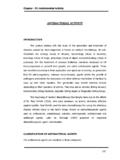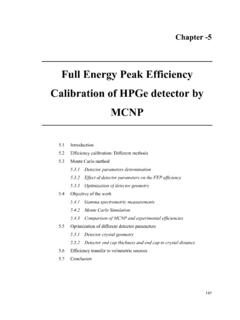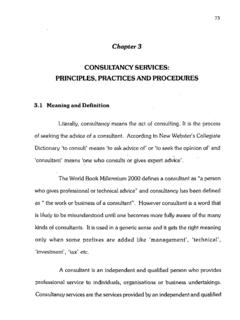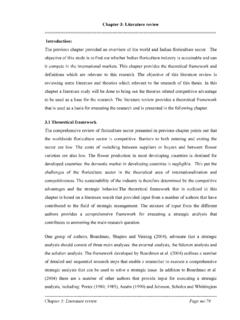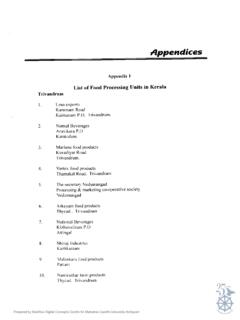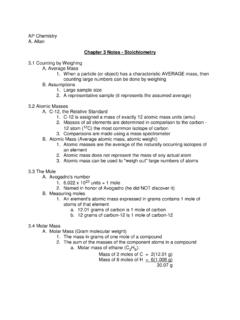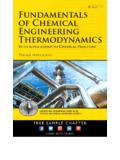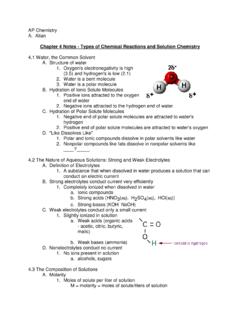Transcription of II EXPERIMENTAL TECHNIQUES 2.1 Introduction
1 CMZIPTER - II. EXPERIMENTAL TECHNIQUES . Introduction Wet Chemical Processes for the Synthesis of Nanocrystalline Oxide Powders Sol-Gel Process Hydrothermal Process Co-Prec~pitationProcess Polyol Process Combustion Process Other Wet Chemical Processes Combustion Processes (Polymeric Precursor and Pechini Processes). Characterization TECHNIQUES TGiDTA and DSC. Founer Transform Infrared Spectroscopy (FTIR). X-Ray Powder Diffraction (XRD). Scanning Electron Microscope (SEM). Transmisston Electron Microscope (TEM).
2 Vibrating Sample Magnetometer (VSM). Fabrication of Lithium Cell Preparation of Cathode Preparation of Anode Preparation of Electrolyte Assembling of Lithium Cell Characterization of Lithium Cell Cyclic Voltammetry Charge - Discharge Studies References chapter - I1. EXPERIMENTAL TECHNIQUES . Introduction Among the available lithium intercalated transition metal oxides, LiCoOl (layer), LiMnaO4 (spinel) and LiNio jC00 sV04 (inverse spinel) have been most studied cathode materials because of their effective electrochemical performance [l-71.]
3 Charge - discharge characteristics of lithium cells are mainly depend on the physical and chemlcal properties of the cathode material such as particle size, purity of the phase. homogeneity, chemical stability, etc. [7-101. Nowadays, there is a great interest in the synthesis of nanocrystalline cathode materials, which show an improved electrochemical performance due to its unusual physiochemical properties compared to their bulk [ 10- 161. Also, nano science has been viewed as the big, which is considered as impute for the next industrial revolution.]]
4 Synthesis and stabilization of nanostructures with required properties are the challenging task, since nano scale materials have large surface area and high reactivity, which tend to react themselves to form necking and hence, agglomerate into large secondary particles [17]. Hence, synthesis process plays an important tool for the design of nanostructures with required properties such as crystallite size, size distribution, shape, homogeneity, etc., in order to meet the requirement for desired specific applications [I 8-21].
5 The preparation of LiCoOz, LiMnzO4 and LiNio sCoo sV04 cathode powders by conventional solid state reaction methods involve heating of precursor materials (in the form of oxides or carbonates or organic derivatives) at higher temperatures, which results in inhomogeneity, bigger crystallite, poor stoichiometry, phase impurity, etc. [22, 271. These problems could be overcome using low temperature wet chemistry methods. Various wet chemical TECHNIQUES such as, sol-gel, hydrothermal, co-precipitation, polyol, combustion.]
6 Etc., have been used for the sqnthesis of u i d e range of multicomponent nanocrystalline oxide powders, including cathode materials [28-351. Wet Chemical Processes for the Synthesis of Nanocrystalline Oxide Powders Sol-Gel Process Sol-gel is the multi step process. mvolving chemlcal and physical processes associated with hydrolysis, polymerization, gelatlon, condensation, drying and densification [36]. This process generally starts with the mixing of metal alkoxides or salts in water or in a suitable solvent (usually an alcohol) at ambient or slightly elevated temperatures [36: 371.]]
7 Schematic diagram of various steps involved in the sol gel process are shown in fig. In sol gel process, controlling the pH of starting solution is very much important to avoid the precipitation as well as to form the homogenous gel, which can achieved by the addition of base or acidic solutions [38). Apart from the above, organic compounds with hydrophilic functional groups (hydroxides or carboxylates) in small molecules such as citric acid, succinic acid, oxalic acid, tartaric acid, acrylic acid, etc. and polymers like polyacrylic acid (PAA) and polyvinyl pynolidone (PVP) can be used with metal ion sources to form the sol as well as control the particle size and uniformity of the products [38-421.]]
8 Chelation of metal ions by carboxylic acid groups lead to a homogeneous distribution of the constituent ions in the obtained gel [43]. The gel intermediate is further heated between 150 "C and 300 "C to eliminate volatile organic components, excess water, etc., which results the dried intermediate powders. Single phase nanocrystalline metal oxides are obtained after calcining of dried gel powder at 400-800 "C depends on the precursor chemical nature [44,45]. Dense Cera~nics Fig. Schematic diagram of various steps involved in the sol-gel process.
9 Advantages of Sol-Gel Process 1. Low temperature processing and consolidation 1s possrble. 2. Smaller particle size and morphological control in poivder synthesis. 3. Sintering at low temperature also possible. 4. Better homogeneity and phase purity compared to traditional ceramic method. Disadvantages of Sol-Gel Process 1. Raw materials for this process is expensive (in the case of metal alkoxides). compared to mineral based metal ion sources. 2. Products would contain high carbon content when organic reagents are used in preparative steps and this would inhiblt densification during sintering.
10 3. Since several steps are involved, close monitoring of the process is needed. Hydrothermal Process Water is an excellent solvent for many ionic compounds. It can dissolve even non- ionic compounds under high pressure and high temperature. In hydrothermal synthesis, the above property of water has been effectively exploited for the preparation of fine powders of metal oxides [46-481. Under these hydrothermal conditions, water plays two roles as pressure transmitting medium and solvent for the precursors. Such hydrothermal conditions effectively brings down the activation energy for the formation of final phase, which can also speed up the reaction between the precursors, otherwise it would occur only at very high temperatures [49, SO].]
